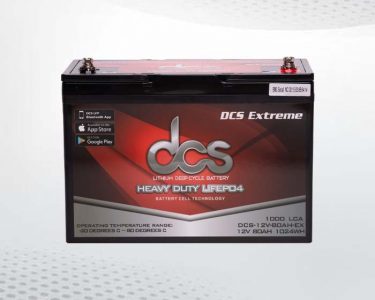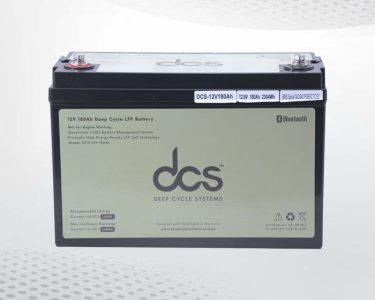In today’s world, where technology plays a crucial role in our daily lives, having a reliable and long-lasting power source is essential. This is where 200ah batteries come in – they are known for their high capacity and ability to provide sustained power for longer periods. Whether you are using them for your caravan, boat, solar system, or as a backup power source for your home, these batteries are a popular choice due to their efficiency and durability. So, let’s get started and discover the power of 200-ah batteries!
Understanding 200-Ah Batteries and Their Applications
200-ah deep-cycle batteries are engineered to dispense power steadily over prolonged periods. These units find their utility in a plethora of settings, prominently in solar energy setups, marine environments, recreational vehicles (RVs), and as reliable backup power sources.
The essence of their design lies in their ability to store substantial energy, thus enabling them to deliver power efficiently when necessitated. Such batteries are pivotal in applications where the demand for consistent and long-duration power supply is paramount.
The versatility extends to various sectors, underscored by their high capacity, which is a testament to their ability to meet the energy requirements of diverse systems. Given their expansive applications, understanding the operational dynamics and the specific contexts in which 200-ah batteries excel can significantly enhance their effectiveness in meeting the power demands of both everyday and specialised tasks.
Types of 200-Ah Batteries Available in the Market
In the realm of 200-ah batteries, consumers are met with various options, each with unique characteristics and advantages. The market predominantly showcases three variants: lead-acid, lithium-ion, and gel batteries. Lead-acid batteries stand out for their cost-effectiveness and proven track record, making them a conventional choice for many. They are particularly noted for their robustness and capacity to endure variable conditions, albeit with a heavier weight and the necessity for regular maintenance.
On the other end of the spectrum, lithium-ion batteries offer a modern approach with their lightweight composition and an extended lifespan, surpassing traditional lead-acid batteries. These units are highly efficient, with a remarkable energy density that allows for a compact size, making them an ideal choice for applications where space and weight are critical factors. However, their advanced technology comes with a higher price tag, which may deter some buyers.
Gel batteries introduce a maintenance-free option. They are encapsulated in a silica gel that immobilises the electrolyte. This design significantly reduces the risk of leaks and provides excellent performance in deep-cycle applications. Gel batteries are well-suited for use in situations requiring reliable power without the necessity for ongoing upkeep.
Each type of 200-ah battery has been tailored to meet specific needs and preferences, offering various solutions to power diverse applications efficiently.
How to Choose the Right 200-Ah Battery for Your Needs
Selecting the appropriate 200-ah battery requires a thoughtful evaluation of several critical factors beyond the initial cost.
Firstly, assess the battery’s primary application; different scenarios, such as daily use in a caravan, a backup power source for home energy systems, or demanding marine applications, will significantly influence your choice. The nature of the application will guide whether a deep-cycle, lead-acid, lithium-ion, or gel battery is most suitable. Each offers distinct advantages in terms of lifespan, maintenance, and performance under various conditions.
Next, consider the environmental conditions the battery will be exposed to. For instance, lithium-ion batteries might be preferable in scenarios demanding lightweight solutions and high efficiency. In contrast, gel or lead-acid batteries could be more suitable for environments where temperature fluctuations are common and rugged durability is required.
Compatibility with existing systems is also paramount. Ensure the chosen battery matches the voltage requirements and can seamlessly integrate with your current setup to avoid potential operational issues. Weighing these considerations carefully will help you make an informed decision, ensuring the selected 200-ah battery aligns perfectly with both immediate needs and long-term expectations.
Best Practices for Installing Your 200-Ah Battery
When installing your 200-ah battery, adhering to established best practices ensures safety and optimal performance.
Select the Proper Location
The installation site should be cool, dry, and well-ventilated. Avoid exposing the battery to direct sunlight or moisture, which can accelerate wear and impair function.
Ensure Secure Mounting
Batteries, especially of this capacity, are hefty. Secure mounting brackets or a battery box will prevent movement that could lead to physical damage or loosened connections.
Verify Polarity Before Connection
Reversing the polarity is a common but dangerous mistake. Always double-check that the battery’s positive terminal is connected to the positive cable and the negative one.
Use the Correct Cabling
The size and type of your cables play a crucial role in efficiency. Too thin wires can cause voltage drops and overheating, so ensure the gauge is appropriate for the current and length of the run.
Incorporate a Fuse or Circuit Breaker
A fuse or circuit breaker within the circuit is critical to protect against overcurrent scenarios that could cause damage or pose a fire risk.
Consult the Manufacturer’s Instructions
Lastly, always refer to the manufacturer’s guidance for specific installation instructions or recommendations to ensure compatibility and safety.
Charging and Maintaining Your 200-Ah Battery for Optimal Performance
Maintaining and charging your 200-ah battery correctly is paramount for its efficiency and longevity. It’s essential to utilise a charger that is not only compatible but also adheres to the manufacturer’s recommended charging protocol. This ensures that the battery is neither overcharged, which can lead to overheating and potential damage, nor undercharged, which can shorten its useful life.
For those with lead-acid types, monitoring and topping up the water level is crucial, along with conducting regular equalisation charges to balance the cells and prevent sulphation. Lithium-ion and gel variants require less hands-on maintenance, but keeping an eye on their state of charge and avoiding complete discharges is beneficial.
Maintaining a routine check on the battery’s terminals is advisable, ensuring they are clean and free from corrosion, which can impede efficient power transfer. Implementing these practices will contribute significantly to sustaining the battery’s peak performance, thereby ensuring that your 200-ah battery serves its full potential lifespan.
Troubleshooting Common Issues with 200-Ah Batteries
Problems with 200-ah batteries can be frustrating but are often resolvable with some troubleshooting steps. Common issues include difficulty holding a charge, unexpected power loss, or reduced efficiency. To address these concerns, examine the charger and the charging process. Ensure the charger is compatible and functioning correctly, as an unsuitable or malfunctioning charger can lead to undercharging or overcharging, adversely affecting the battery’s health.
Check the connections and terminals for any signs of corrosion or looseness. Corroded terminals or loose connections can impede the flow of electricity, leading to suboptimal performance. Cleaning the terminals with a mixture of bicarbonate of soda and water, followed by tightening the connections, can often remedy this issue.
For those experiencing a rapid decline in battery capacity, conducting a capacity test can help determine the extent of the degradation. This involves fully charging the battery and measuring how long it can sustain a designated load before reaching a critical discharge point. Should the capacity be significantly lower than expected, it may indicate the battery is nearing the end of its usable life.
In instances where the battery frequently becomes deeply discharged, consider implementing a usage strategy that avoids deep discharge cycles, as these can severely shorten the battery’s lifespan.
Should these steps not resolve the issue, consulting the manufacturer’s support may provide further guidance. Additionally, some batteries may still be under warranty, offering a replacement option for units that fail prematurely due to manufacturing defects.
Maximising the Lifespan of Your 200Ah Battery
To ensure the enduring efficiency and lifespan of a 200ah Battery, it’s crucial to adopt a diligent approach towards its maintenance and usage. A pivotal aspect is circumventing deep discharges as much as possible and striving to keep the discharge depth under 50% for optimal outcomes.
Regular and appropriate charging plays a significant role; utilise a smart charger that can adapt the charging cycle according to the battery’s condition, thus avoiding overcharging and undercharging scenarios. Maintaining the cleanliness of the battery cannot be overstated – ensure the terminals and surrounding areas are free from dirt and corrosion, which could impede performance.
Moisture is a known adversary of battery longevity; hence, keeping the battery in a dry environment mitigates the risk of damage. A routine inspection and maintenance schedule enables early detection of potential issues, facilitating timely intervention.
For those seeking to enhance their battery’s lifespan further, using a battery management system (BMS) can offer invaluable benefits by continuously monitoring and adjusting the battery’s operation to maintain its health. By adhering to these guidelines, the functionality and durability of the 200-ah battery can be significantly prolonged, ensuring reliable power for an extended period.
Operating 200-Ah Batteries in Extreme Temperatures
Navigating the challenges posed by extreme temperatures is crucial for maintaining the efficiency and prolonging the lifespan of 200-ah batteries. High temperatures can lead to increased self-discharge rates and accelerated degradation of battery components, whilst cold conditions may significantly reduce the battery’s capacity and ability to deliver power. To mitigate these effects, it’s important to implement strategies that address the specific challenges of your climate.
For environments subject to high temperatures, creating a shaded or otherwise cooled space for the battery can prevent excessive heat exposure. Active cooling methods, such as fans or air conditioning units, can effectively regulate the battery’s temperature within safe operational limits. Conversely, in colder climates, insulation techniques can help maintain the battery’s warmth, reducing the impact of low temperatures on its performance. A battery heating system can further ensure the battery operates efficiently, even in freezing conditions.
Regular monitoring of the battery’s temperature through built-in sensors or external devices can provide valuable insights into its thermal state, enabling timely interventions when temperatures stray from the ideal range. Adjustments to charging rates and depths of discharge may also be necessary to accommodate the temperature’s influence on the battery’s behaviour, ensuring optimal performance under all conditions.
Safety Precautions When Using a 200-ah Battery
When handling and operating 200-ah batteries, prioritising safety is paramount to prevent accidents and ensure a secure environment. It is crucial to wear appropriate personal protective equipment, such as safety glasses and gloves, to protect against acid spills and electrical shorts. Ensure that the area around the battery is well-ventilated to mitigate the risk of gas accumulation, which could lead to explosive conditions. It is also important to keep open flames or sparks away from the battery to prevent the ignition of any flammable gases emitted during charging.
Moreover, be mindful of the battery’s weight and follow proper lifting techniques to avoid physical injury. Always disconnect the battery during maintenance or adjustments to prevent accidental short circuits. Additionally, storing the battery in a designated area away from children and pets reduces the risk of unintentional exposure to its contents or potential electric shock. By adhering to these safety measures, users can significantly minimise the risks of using 200-ah batteries.
Using 200-Ah Batteries for Off-Grid Living
Thanks to their considerable capacity and durability, 200-ah batteries present an efficient solution for energy storage for individuals venturing into off-grid living. Key to harnessing their potential is a detailed evaluation of your energy needs to align with the capacity of these batteries. It ensure that your daily power consumption is adequately met.
Integrating renewable energy sources, such as solar panels or wind turbines, is essential for the sustainable charging of these batteries. It enables a seamless transition to renewable energy, reducing reliance on traditional power grids and fostering a more sustainable lifestyle.
Equally important is designing a system with sufficient storage capacity to handle peak energy demands, including provisions for days with low sunlight or wind activity. Strategic planning of energy usage and investing in energy-efficient appliances can significantly enhance the effectiveness of your off-grid system. Adopting 200-ah batteries within a well-considered off-grid setup allows you to enjoy a reliable and autonomous power supply, making off-grid living both practical and enjoyable.
Conclusion
Embracing the robust potential of 200ah batteries offers an avenue to achieve energy independence and operational efficiency across various applications. Individuals can significantly enhance their energy systems’ reliability and longevity by judiciously selecting, installing, and maintaining these batteries. As technology evolves, so too does the capability of these batteries to meet the growing demands of modern energy needs. It marks a pivotal step towards a more resilient and sustainable energy landscape.
FAQs
What is the lifespan of a 200-ah battery?
The lifespan varies by type and usage; typically, lithium-ion batteries last 5-7 years, while lead-acid types may last 3-5 years with proper maintenance.
Can I use a 200-ah battery for my home solar system?
Yes, 200-ah batteries are excellent for solar systems. They provide ample storage for energy captured during the day to be used at night or during low-Sunday periods.
How do I know when my 200-ah battery needs replacing?
Indicators include reduced capacity, inability to hold a charge, or visible damage. Conducting regular capacity tests can help determine its health.
Can multiple 200-ah batteries be connected?
You can connect them parallel to increase capacity or in series to increase voltage, but ensure they are the same type and age for optimal performance.
Can a 200ah Battery be recycled?
Yes, they are recyclable. Lead-acid, lithium-ion, and gel batteries should be taken to a specialised recycling facility to ensure proper handling and disposal.
| Related Business Listings |
| Directory Submissions |
| Regional Directory |








1 Comment